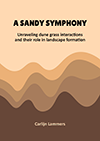PhD defence Carlijn Lammers
| When: | Tu 02-04-2024 at 14:30 |
| Where: | Academy Building & online |
Carlijn Lammers (Conservation Ecology)
Promotor: Prof. T. van der Heide; copromotor Dr V. Reijers (RUN)

A sandy symphony
Unraveling dune grass interactions and their role in landscape formation
Coastal dunes occur worldwide along sandy shorelines where they provide essential services such as flood protection, drinking water supply, and recreation. In my thesis, I explored the dynamics of dune formation and development, focusing on the interactions between ecosystem engineering dune grasses, environmental factors, and landscape morphology. First, I compared the clonal expansion strategy of two co-occurring dune grass species (marram grass and sand couch) along the Northwestern European coast, which determines their dune building capacity. I discovered that sand couch grows dispersed, resulting in low and broad dunes, while marram grass generally grows patchier and adapts flexibly to environmental conditions. Next, I investigated how established dune grasses influence the establishment of other dune grasses through the formation of embryonic dunes. Firstly, by examining how marram grass affects the establishment of conspecifics, revealing a negative effect of dune formation due to increased sediment dynamics and elevation. Then, I determined the relationship between sand couch, its landscape characteristics, and the establishment of marram grass, uncovering indirect negative effects of sand couch on marram grass survival through landscape formation. Finally, I determined how extreme conditions, simulated as heat and drought, influences the interaction between sand couch and marram grass. Despite the expected impact of extreme conditions, the presence of sand couch emerged as the predominant factor reducing marram grass growth. My research emphasizes the importance of biophysical interactions at different scales in dune formation. Understanding these interactions is crucial for effective management and restoration efforts.
